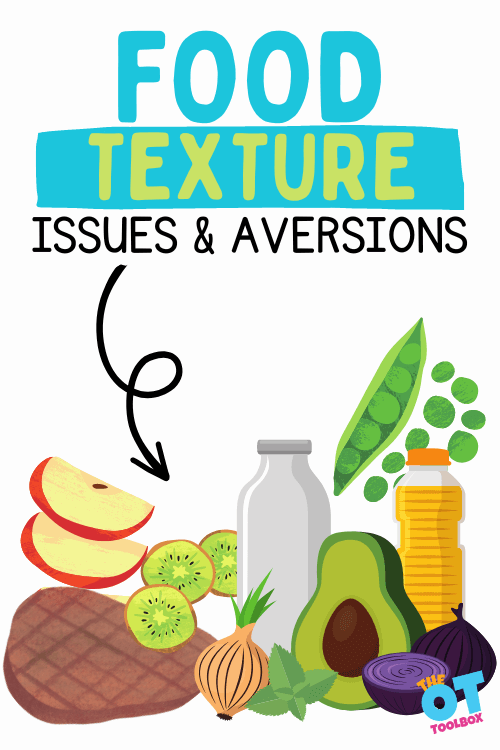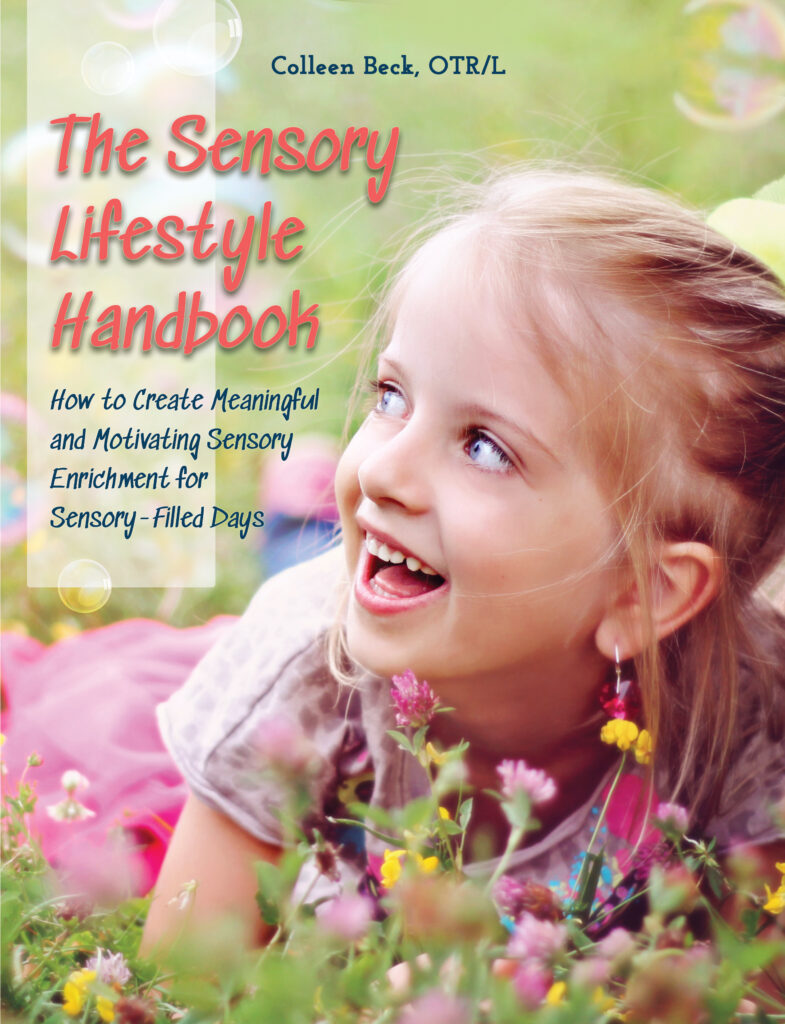A child with food texture issues can have a lot going on beneath the surface. What looks like extremely picky eating can be texture aversions that impact nutritional intake and participation in meals. Let’s explore specifically food texture sensitivity and what to do about this aspect of “picky eating”.

This may be a complicated topic, because what one person deems “picky” may be another person’s dream diet. It’s all subjective, to say the least. But when does food preference become an issue and who can help? Sometimes young children can have sensory food aversions to specific textures. It’s here that we’re covering specific and common food texture sensitivity that we see in children.
An occupational therapist can help, of course!
Related: Not sure if you have a picky eater? Seeking out an occupational therapist to complete a feeding evaluation is key. Also be sure to check out the Food Inventory Questionnaire for more clarity.
TYPES OF FOOD TEXTURE ISSUES
When food texture issues are the main culprit of a nutrition deficit, an occupational therapist can help you and your family identify the underlying factors and provide solutions to develop a broader food acceptance. Now, let’s dive into the various types of different textures of food and try to get into the mindset of a “picky eater”.
Some things to consider are the various textures that a single type of food can have. When you break down each type of food, you can see how a child might have a fear of food textures. The foods they are eating might be different each time they try them!
Fruit Textures
In the fruit category, we have lots of different textures going on. You may come across a child who eats certain kinds of fruits, like grapes, but will not touch foods of a different texture, like strawberries. But why is sensory touch an issue? Let’s break down the various textures, both inside and outside of some common fruits:
- Smooth fruits: grapes, apples, blueberries, coconut
- Soft/slimy fruits: mangos, bananas, pears, peaches
- Rough/bumpy texture fruits: strawberries, blackberries, raspberries, any fruit with edible seeds!
- Crunchy fruits: apples, pomegranate; underripe honeydew, cantaloupe, or nectarines
- Wet/Juicy fruits: pineapple, overripe berries, pears, oranges, kiwis, watermelon
Meat Textures
Various meats are very common for children to avoid because of the meat textures. Oftentimes, the exception here is with processed meats like we would find in chicken nuggets.
The texture of tough meat can be really difficult to chew as an adult, much less a child. Because the texture is so different from what many babies start out eating (purees), the introduction to meat may be a bit of a shock for toddlers.
- Meat texture can range from crumbly (ex: ground beef) to stiff (ex: chicken breast) and from wet (ex: rarer steak) to dry (ex: plain baked turkey).
- If a child is averse to meat, try offering it in many different forms before ruling it out! I find that cold cuts are often the most accepted of meats (besides chicken nuggets), usually offered on their own or alongside other sandwich foods.
Cheese Textures
While there are harder cheeses, most toddlers are exposed to softer cheeses like mozzarella string cheese or sliced American or cheddar cheese. However, the temperature of these cheeses changes their textures.
We need to think about what reactions we get for something gooey like a grilled cheese sandwich versus something more firm, like a string cheese straight from the fridge.
- Most cheese is smooth and soft, meaning that the sensory input is fairly “low”. I have the word “low” in quotation marks because although it may seem like it is not very much input compared to something harder, crunchier, or bumpier, it may still be a texture that is non-preferred for some, leading it to feel like a much greater sensory experience for them.
Pureed Foods
Pureed foods, and foods with a pureed consistency are often the most accepted foods on this list, as they are introduced very young and do not need to be touched by the hands to eat.
Using a spoon instead of the fingers reduces the amount of sensory nerve stimulation that is associated with the food texture, and is, therefore, lighter on the system.
- Pureed foods have a soft, silky, slimy, slippery texture. They do not require much activity from the mouth to eat – no chewing or moving the food about – all they have to do is swallow. This limits the amount of time to experience the food texture as well.
- If your toddler is stuck on purees, try first to introduce purees with chunks. Oatmeal is a good option in this category as well.
Texture of Bread
Most toddlers love bread. The texture of bread is soft, smooth, not very complex in flavor, and easy to chew. It’s a calming food texture to eat!
Just like cheese though, the texture of bread can change, or be different depending on warmth of bread and especially the type of bread. In the case of bread, the texture changes when you toast it or add anything as a topping.
- Texture changes between the middle of bread and the crusts may be why so many children prefer their sandwiches crustless! If your child does love bread but has limited nutritious foods in their repertoire, consider enriched breads with whole grains to try and fill that gap.
Cracker Texture
Crackers share some of those characteristics: they are generally smooth and lightly flavored, but they are moderately crunchy. The addition of a “crunch”, or being a firmer item in general, may be the difference between your child being able to eat bread, but not crackers.
- Crackers can vary from brand to brand. Goldfish crackers from the commonly known brand can have a different taste and texture than a generic or store-bought brand. Similarly, a saltine can differ from brand to brand.
This list of foods and associated textures is certainly not exhaustive, but we hope you can use it as a resource to think about food textures moving forward.
HOW TO BROADEN FOOD ACCEPTANCE
There are many ways to address food texture issues so that nutritional input is broadened to a healthy diet. Some of these considerations are occupational therapy interventions that may be addressed in therapy sessions. Below, we’re covering:
- Oral sensory strategies for food texture sensitivity
- Play-based strategies for addressing texture sensitivities
- Explore food texture issues by playing with food
- Texture exploration without food
Oral Sensory Techniques for food texture issues
They are various ways to improve texture acceptance, but not very many that we can discuss without knowing more specifics about which food textures are causing an issue. Broadly speaking, alerting techniques are recommended for kiddos that have limited food texture tolerance.
Alerting sensory techniques for feeding involve increasing stimulation to the nerves in the mouth in a way that the child enjoys. By increasing input in a positive way, the nerves become desensitized and primed for experiencing more textures.
If this were completed in a fashion that the child did not enjoy, the technique is no longer valid. In other words, forcing someone to do something they dislike is never a good way to increase that behavior in the future.
Examples of alerting sensory input for feeding include:
- Cold items like popsicles or frozen teethers/chewies
- Vibrating items like an electric toothbrush or a (Amazon affiliate link) z-vibe
- Fun candies like pop-rocks (for that sizzle and bang!) or rock candy (for that super interesting mix of sharp, smooth, and crunchy texture). Candy is not the best mechanism for broadening a diet, but it can be a very well-accepted item that provides a new texture to the mouth.
Alerting sensory inputs are not only beneficial for increasing food tolerance, but they are also great for attention, self-regulation, and more! Check out our posts about Sensory Popsicles and Sensory Water Bottles for more information on that.
Play-Based Sensory Techniques for Issues with Food Texture
In conjunction with oral sensory techniques, I always offer families ideas to explore various textures in and out of the kitchen.
Explore Food Texture Issues by Playing with Food
Important Disclaimer: Families that are not comfortable using food for non-nutritive purposes, like some of the activities below, should refrain from doing so. You know your family’s needs best!
- Play pretend to feed a baby doll
- Embrace messy eating and food play
- Involve your child with the cooking process
- Scooping and pouring or Baking Activities
- Cooking With Kids Recipes
- Make a necklace or craft out of the food items
Exploring Texture sensitivity through Play without Food
You can use pretend foods during playtime (they could be invisible or plastic/wood), or create a themed sensory bin using a variety of sensory bin bases for various textures. But really, ANY way to increase your child’s sensory input, especially to textures, will benefit their feeding experience. Remember that these items do not need to be mouthed to help. Just touching the skin increases texture tolerance. Here are some ideas:
- Crawling or rolling on grass
- Scooping and dumping sand
- Making and playing with sensory doughs
- Collecting rocks or seashells
- Picking dandelions
- Water play (bathtub/ buckets/ bowls/ water table or pool)
- Popping bubbles
- Play dough activities galore
- Sequined items to manipulate
- Exploring textures in the backyard
Other Mechanisms to Solve Food Textures Issues
I will be the first to admit that sometimes, picky eaters are just picky eaters regardless of the sensory experience. If this is the case for your little one, I would check out Kids Eat in Color, a nutritionist who has tons of great resources for families with questions about picky eaters.
Also, your OT may suggest other ways to increase functional independence during meal times with some adaptive equipment for eating. Although it may be stressful, try to keep mealtimes low-pressure and fun!
The Sensory Lifestyle Handbook walks you through sensory processing information, each step of creating a meaningful and motivating sensory diet, that is guided by the individual’s personal interests and preferences.
The Sensory Lifestyle Handbook is not just about creating a sensory diet to meet sensory processing needs. This handbook is your key to creating an active and thriving lifestyle based on a deep understanding of sensory processing.

Sydney Thorson, OTR/L, is a new occupational therapist working in school-based therapy. Her
background is in Human Development and Family Studies, and she is passionate about
providing individualized and meaningful treatment for each child and their family. Sydney is also
a children’s author and illustrator and is always working on new and exciting projects.



